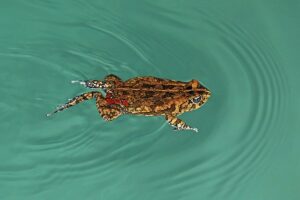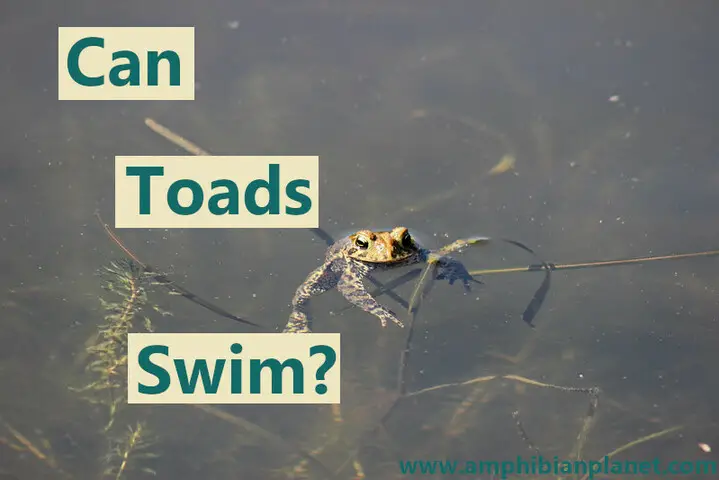Many people know that most frogs love to hang around water and are very efficient swimmers. Toads are a type of frog, so you may be wondering if they too can swim. So, can toads swim?
All toads can swim. However, toads generally live a more terrestrial life than true frogs, so they are not as strong of swimmers. Toads typically begin their lives as tadpoles that live in the water – as they grow, they leave the water for a life on land. As such, they are natural-born swimmers.
A few toad species do not have tadpoles and breed entirely on land. They either lay eggs which then hatch into miniature toads, or keep the eggs inside their bodies and give birth directly. Still, even these can swim but only for short periods.
Toads Have Different Swimming Abilities at Different Stages of Their Life
Most toads (not all) develop in three life stages: Egg, tadpole, and adult.
Female toads lay eggs in shallow fishless ponds, deep puddles, or other fishless water bodies. Unlike most true frogs which lay their eggs in masses; toads lay their eggs in long strings, usually one to three eggs wide. The egg strands are placed on submerged vegetation or rest on the pond’s bottom.
After one to three weeks, tiny tadpoles hatch from these eggs. The tadpoles have gills, and live entirely in the water, just like fish.
Over time, the tadpoles will go through a process known as metamorphosis in which they will transform into sub-adult toads (toadlets) with features for a terrestrial life. Once fully transformed, they will leave the water for a life on land, sometimes only returning to the water to breed.

During these different life stages, toads have slightly different swimming abilities.
Baby Toads (Tadpoles) Are Very Strong Swimmers
Larval stage toads (toad tadpoles) are very different from adult toads. This is because they’re adapted for a fully aquatic life (life in the water), while adult toads are adapted for a mostly terrestrial life (life on land).

Toad tadpoles live entirely in the water; they have external gills and a flat paddle-like tail fin, to help them move in the water. They swim by flapping their tail from side to side and are excellent swimmers.
In fact, at this stage, they do not yet have features for a life outside of the water, so if they are taken out of the water for too long, they can suffocate and die.
Tadpoles Transform Into Adults
After a period of 2 to 3 weeks to as long as over 3 months (depending on the species), the tadpoles go through a process known as metamorphosis. In this process, they lose the features that help them live in the water and develop features more suitable for living on land.

During this process;
- They lose their gills and get well-developed lungs for breathing air
- The tail shortens and is eventually absorbed into the body
- They develop strong legs for moving on land
Once this process is complete, tiny toadlets (small toads), typically half an inch long will leave the water and live a fully terrestrial life.
These toadlets will grow into adult toads and once they mature, they will go back to the water to breed and lay their eggs.
Adult Toads Are Not Very Strong Swimmers
Adult toads spend most of their lives on land and rarely go into the water. This means their features are mostly adapted for a life on land rather than in the water, so they are not very strong swimmers. Still, they are very decent swimmers.

Why Adult Toads Are Not Strong Swimmers
Toadlets and adult toads typically have short hind legs (for walking or hopping short distances) and non-webbed feet (they typically have digits or spaded feet).
This is in contrast to most true frogs which have long powerful hind legs (for hopping long distances & propelling themselves in water) and fully webbed feet.
This difference means toads can not swim as strongly or as efficiently as most true frogs can.
Since they spend the majority of their time on dry land, their hind legs are more adapted for digging burrows in soft soil or mulch where the toad can hide and protect itself from the elements.
How Do Toads Swim?
Toads swim by pushing water backward with their hind legs, just like how true frogs swim. The legs are usually kicked back simultaneously, but they can sometimes move independently, particularly during slow swimming.
Here is a video of a toad swimming around.
Can Adult Toads Breathe Underwater?
Adult toads can breathe underwater by absorbing oxygen that comes in contact with their skin. This is known as cutaneous respiration (sometimes informally called “skin breathing”).
Their skin contains thousands of capillaries and other blood vessels very close to the skin’s surface. Dissolved oxygen in the water that comes in contact with this skin is absorbed into the bloodstream via diffusion.
At the same time, carbon dioxide from the bloodstream passes through the skin and is diffused into the water.
The oxygen they get from this is usually insufficient so they can only stay underwater for a limited time before they have to visit the water surface to breathe air with their lungs.
How Long Can Toads Stay Underwater?
How long a toad can stay underwater depends on how much oxygen it can absorb from the water vs how much oxygen its body needs.
This is usually determined by three main factors: The oxygen content of the water, the temperature, and how active the toad is.
1. The Oxygen Content of the Water
Fast-moving or ‘stirred up’ water generally contains more oxygen than still water. This is because oxygen from the atmosphere mixes with the water easier.
If water is very still, oxygen only dissolves on the water’s surface, and anything below the upper layer of the water will have a low oxygen content.
In addition, water with lots of decaying plants will have a lower oxygen content. This is because the bacteria responsible for the process of decomposition use oxygen and release carbon dioxide into the water, reducing the oxygen content of the water.
Toads can stay underwater in water with a high oxygen content for much longer than they can in water with low oxygen content.
2. Temperature
Toads are ectothermic (cold-blooded) animals, so the environmental temperatures will affect their rate of metabolism. At higher temperatures, they will have a higher metabolic rate, meaning they have a greater oxygen demand.
At lower temperatures, the opposite is true. Toads will have a lower metabolic rate meaning they have a lower oxygen demand.
Also, the temperature will affect the oxygen content of the water. More oxygen will dissolve into the water at colder temperatures, than at warmer temperatures.
This means toads can stay underwater at lower temperatures for much longer than they can at warmer temperatures.
3. How Active the Toad Is
Activity affects how much oxygen the body needs. Think about it, when we are running or jogging, we breathe heavier and in much quicker breaths than when we are at rest.
For toads, this is also true. They will have a higher oxygen demand when they are very active in the water (escaping a predator for example), and a lower oxygen demand when they are inactive.
For this reason, toads will be able to stay underwater when at rest for much longer than when they are active.
Can Toads Drown?
Even with their ability to breathe underwater, toads can drown if they are prevented from surfacing for air. Toads have lungs, just like we humans do. If their lungs fill with water, they can drown.
The oxygen they absorb through their skin is not enough, so they can only stay submerged for a limited time before they will have to surface to breathe air with their lungs.
If a toad gets in water so deep that it can not surface or get out of the water, it will drown.
What to Do if You Find a Toad in Your Pool or Pond
During the spring when the temperatures are warm and wet, toads and other amphibians wander further from their usual habitats and often end up in people’s backyards. When this happens, they can fall into ponds or swimming pools with no way of getting out on their own.
Falling into a pond without any chemicals in the water will usually not be of much harm to the toad. However, falling into a swimming pool can be highly dangerous because the chlorine found in pools can penetrate the toads’ absorbent skin, and cause serious harm.
For this reason, you have to remove toads that fall into your pool (or pond) as fast as possible.
You could manually fish them out with a hand net, but this would be hard work because you would have to keep checking your pool for any toads. Even worse, the toad could drown or be killed by the chlorine in the pool (if it falls into your swimming pool) before you have a chance to get it out.
The best thing to do is to prevent them from falling into your pool in the first place. You can do this by laying wooden boards at least a foot high around your pool to create barriers. This barrier will act as a ‘wall’ and prevent toads or other amphibians from falling into your pool.
Still, some toads may be able to pass through this barrier. So you can set up an escape ramp like the Froglog escape ramp (link to Amazon) to help any amphibians that fall to get out on their own.
Frequently Asked Questions
Can toads live in water? Toads can only live in water as tadpoles. Once they transform into toadlets, they will have to leave the water for a life on land.
Adult toads cannot live in water because their features are more adapted for a life on land than in the water. They live on land and typically only return to the water to breed and lay their eggs.
Can toads live without water? Toads are amphibians, which means they spend part of their lives in the water, and part on land. This means they cannot live without water.
Adult toads typically live in humid habitats near bodies of water where they can keep cool. Also, toads need to drink water, they do so by absorbing it through their semi-permeable skin.
Conclusion
Toads typically start their lives as fully aquatic tadpoles; in this stage, they are very strong swimmers.
Over time, the tadpoles will grow and go through metamorphosis and transform into toadlets that live entirely on land. These toadlets will grow into adult toads that spend the majority of their time on land, usually only going to the water during the breeding season.
Adult toads can swim, however, they are not very strong swimmers. They have short hind legs and non-webbed feet that are more adapted for digging burrows on land than they are for swimming.


